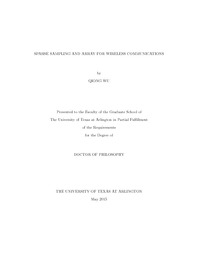
ATTENTION: The works hosted here are being migrated to a new repository that will consolidate resources, improve discoverability, and better show UTA's research impact on the global community. We will update authors as the migration progresses. Please see MavMatrix for more information.
Show simple item record
| dc.contributor.author | Wu, Qiong | en_US |
| dc.date.accessioned | 2015-07-31T22:10:05Z | |
| dc.date.available | 2015-07-31T22:10:05Z | |
| dc.date.submitted | January 2015 | en_US |
| dc.identifier.other | DISS-13058 | en_US |
| dc.identifier.uri | http://hdl.handle.net/10106/25029 | |
| dc.description.abstract | In recent years, sparse sampling and array, such as coprime sampling, nested sampling, nested array, attract attention for their potential to estimate autocorrelation coefficients with all lags, and to calculate the power spectrum density. But this theoretical merit is based on the premise that the input signals are wide-sense stationary. This dissertation first implements the coprime sampling for non-stationary signal, which still decreases the computational complexity but suffers from high variances due to lack of observations. Then, this algorithm is extended to calculate ambiguity function in the radar system, and several practical guidelines are concluded in order to conduct the sparse sensing while retain the detection quality.The dissertation also proposes an algorithm deriving higher-order statistics (HOS) from the co-prime sampling and implements it in the order determination. Specifically, it is extended to pairwise co-prime sequences (PCS) for calculating HOS, and singular value decomposition (SVD) is used to the matrix formed by third-order cumulants to determine the order of the autoregressive model. In this scenario, PCS-based HOS algorithm enlarges the variance of third-order cumulants, which provides better indicator to determine the order of moving average (MA) model.Furthermore, the dissertation extended the derivation of HOS based on nested sampling. It develops multilevel nested sampling (MNS) algorithm to obtain higher-order statistics (HOS), and analyzes the computational complexity of the MNS-HOS algorithm for both parametric and nonparametric methods. Compared to the existing HOS algorithms, the proposed algorithm vastly reduces the complexity by several orders in terms of the length of segmentation window. It also applies MNS-HOS algorithm to estimate the coefficients of a simplified LTE spatial channel model blindly without using any training sequences.Moreover, the dissertation proposes a novel deployment for multi-cell cooperative cellular networks based on the two-dimensional (2D) nested co-array, and analyzes its sum-rate capacity and spectrum efficiency. It takes advantage of the invariance in the difference co-array so that the 2D nested array is able to calculate all elements in the covariance matrix of channel fading coefficients. Based on this premise, it demonstrates that the derivation procedure of average sum-rate capacity for the cooperative cellular networks is still valid for the nested distributed base stations (BSs) in the non-fading and Rayleigh fading channels. Given the same number of BSs, the proposed distribution significantly increases the sum-rate capacity of the system.In addition, the dissertation also derives nested deployment for the hybrid wireless networks, and analyzes its ergodic throughput capacity in Rayleigh fading channels. As opposed to the existing hybrid wireless networks in which BS only serves individual cell area, the model of nested distributed BSs can be regarded as a multi-cell virtual multiple-input and multiple-output (MIMO) system. Meanwhile, the 2D nested deployment maximizes the degrees of freedom offered by the existing BSs from $O(N)$ to $O(N^2)$, in which the $N$ stands for the number of BSs within the system. The ergodic capacity is investigated as an indicator of the system performances. | en_US |
| dc.description.sponsorship | Liang, Qilian | en_US |
| dc.language.iso | en | en_US |
| dc.publisher | Electrical Engineering | en_US |
| dc.title | Sparse Sampling And Array For Wireless Communications | en_US |
| dc.type | Ph.D. | en_US |
| dc.contributor.committeeChair | Liang, Qilian | en_US |
| dc.degree.department | Electrical Engineering | en_US |
| dc.degree.discipline | Electrical Engineering | en_US |
| dc.degree.grantor | University of Texas at Arlington | en_US |
| dc.degree.level | doctoral | en_US |
| dc.degree.name | Ph.D. | en_US |
Files in this item
- Name:
- Wu_uta_2502D_13058.pdf
- Size:
- 7.778Mb
- Format:
- PDF
This item appears in the following Collection(s)
Show simple item record


